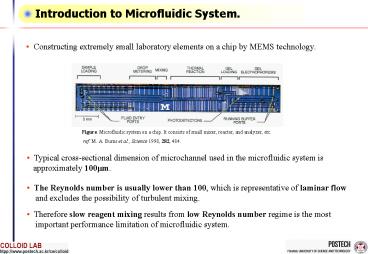Introduction to Microfluidic System. PowerPoint PPT Presentation
1 / 12
Title: Introduction to Microfluidic System.
1
Introduction to Microfluidic System.
- Constructing extremely small laboratory
elements on a chip by MEMS technology.
Figure. Microfluidic system on a chip. It
consists of small mixer, reactor, and analyzer,
etc.
ref. M. A. Burns et al., Science 1998, 282, 484.
- Typical cross-sectional dimension of
microchannel used in the microfluidic system is
approximately 100mm.
- The Reynolds number is usually lower than 100,
which is representative of laminar flow and
excludes the possibility of turbulent mixing.
- Therefore slow reagent mixing results from low
Reynolds number regime is the most important
performance limitation of microfluidic system.
2
Micromixer built in Microfluidic System.
- Static micromixer do not require any moving
parts, and mixing is obtained by the natural
motions of the fluids.
- There are various types of pressure driven
micromixer shown below.
- Electroosmotical driven flow is an alternative
to pressure driven flow in microchannel due to
the controllability of fluids.
3
Electroosmotic Flow used in Microchannel.
- Recently, electroosmosis is used in
microfluidic system due to the advantages of
valveless control and transportation of fluids
without dispersion.
- Electroosmotic flow is developed in a capillary
when the capillary has electrical charges,
the fluids are electrolytes and external electric
fields are applied.
- Rapid reagent mixing is achieved by controlling
surface charge distribution, external
electric field or electrolyte concentration.
4
Electroosmotic Flow by Surface Charges.
- Non-uniform surface charges distribution
generates vortical flow in microchannels.
ref. A. Ajdari, Phys. Rew. E 1996, 5, 4996.
- The two types of patterns act as a basis from
which more general three dimensional flows.
e.g., helical flow over bands of positive and
negative charged bands running diagonally to the
axis of channel ref. A. D. Stroock, Phys.
Rew. Lett 2000, 84(15), 3314.
- However, the diagonal surface charge band
induces not helical motion but small vortical
flow.
Figure 2. Particle trajectories in a diagonal
surface charge band type microchannel. The
dimension of the microchannelis 200mm?70mm?2mm.
5
Electroosmotic Flow by External Electric Field.
- Electroosmotic flow runs parallel to the
electric field.
- It is needed perpendicular electric field along
with parallel external electric field to
induce helical flow.
- We should obtain the entire electric field to
get flow field in the microchannel.
6
Our Microchannel Description.
- Our microchannel has scale of length, 100mm and
velocity 100mm/sec. Then the Reynolds number
of our microchannel is less than 1.
where r is the density of fluid, m the viscosity
of fluid, Lc the length scale of
channel, Uc the velocity scale of channel.
- The electroosmotic helical flow field are
governed by steady Stokes equations.
where v is the velocity of fluid, p the pressure.
- The boundary condition is as following.
where e is the permittivity , z the zeta
potential of channel, E the electric
field, x the position vector.
7
Numerical Description.
- Three-dimensional BEM is used to obtain the
entire electric field.
- Three-dimensional FDM in Flow3D package is
used to obtain the flow field.
- Scale of the microchannel is 100mm?100mm?1mm.
- Electric field strength is less than 10kV/m to
avoid hydrolysis.
- Then the representative velocity is order of
100mm/sec.
- We simulate the flow field and electric field
within one set of additional electrode.
8
Electric Field at the Bottom Surface.
- Parallel electric field (E) strength is
fixed, 10kV/m and perpendicular electric field
(E?) strength is varied to generate various
electric field shown below.
- As the ratio of E to E? decrease, the slop of
electric field is getting more steeper.
- Electric field on the other surface is not much
affected by additional electrode.
9
Electroosmotic Helical Flow Field in the
Microchannel.
- We obtain electroosmotic helical flow field
with slip velocity approximation.
10
Reagent Mixing with Electroosmotic Helical Flow.
- We examine the reagent mixing by two groups of
particles. They are mixed together within 1
cycle (1mm).
11
Effect of Additional Electric Field Strength.
- We examine the mixing efficiency by different
E to E? ratios.
(a)
(b)
t1.0
t2.0
t3.0
t4.0
t5.0
t6.0
t7.0
t8.0
t9.0
t10.0
Figure. Particle trajectories of two different
colored groups of particles at two different
electric field strength ratio. (a) EE?12,
(b) EE?10.5.
12
Conclusions.
- Nonuniform surface charge distribution can not
produce the electroosmotic helical flow.
- Perpendicular electric field in addition to
parallel external electric field is needed to
generate electroosmotic helical flow.
- The electroosmotic helical flow gives rapid
reagent mixing in microfluidic system as a
passive micromixer.
- The suitable selection of additional electric
field strength is 2 times greater than parallel
external electric field, e.g., E1.4kV/m,
E?2.8kV/m.
- In addition, the electroosmotic helical flow
may use in micro protein isomer separator by
amplifying small electrophoretic mobility
differences of protein isomers.
Acknowledgement This work was supported by Grant
R01-2001-00410 from the Korea Science and
Engineering Foundation and also by the Ministry
of Education under the BK21 program.

